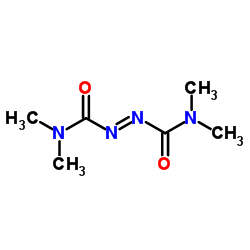N,N,N',N'-Tetramethylazodicarboxamide

N,N,N',N'-Tetramethylazodicarboxamide structure
|
Common Name | N,N,N',N'-Tetramethylazodicarboxamide | ||
|---|---|---|---|---|
| CAS Number | 10465-78-8 | Molecular Weight | 172.185 | |
| Density | 1.1±0.1 g/cm3 | Boiling Point | 220.4±23.0 °C at 760 mmHg | |
| Molecular Formula | C6H12N4O2 | Melting Point | 112 °C | |
| MSDS | Chinese USA | Flash Point | 87.1±22.6 °C | |
|
Carbocysteine restores steroid sensitivity by targeting histone deacetylase 2 in a thiol/GSH-dependent manner.
Pharmacol. Res. 91 , 88-98, (2015) Steroid insensitivity is commonly observed in patients with chronic obstructive pulmonary disease. Here, we report the effects and mechanisms of carbocysteine (S-CMC), a mucolytic agent, in cellular and animal models of oxidative stress-mediated steroid insen... |
|
|
Redox state of p63 and p73 core domains regulates sequence-specific DNA binding.
Biochem. Biophys. Res. Commun. 433(4) , 445-9, (2013) Cysteine oxidation and covalent modification of redox sensitive transcription factors including p53 are known, among others, as important events in cell response to oxidative stress. All p53 family proteins p53, p63 and p73 act as stress-responsive transcript... |
|
|
Viscoelastic transient of confined red blood cells.
Biophys. J. 108 , 2126-36, (2015) The unique ability of a red blood cell to flow through extremely small microcapillaries depends on the viscoelastic properties of its membrane. Here, we study in vitro the response time upon flow startup exhibited by red blood cells confined into microchannel... |
|
|
Neutral sphingomyelinase-2 is a redox sensitive enzyme: role of catalytic cysteine residues in regulation of enzymatic activity through changes in oligomeric state.
Biochem. J. 465(3) , 371-82, (2015) Neutral sphingomyelinase-2 (nSMase-2) is the major sphingomyelinase activated in response to pro-inflammatory cytokines and during oxidative stress. It is a membrane-bound 655 amino acid protein containing 22 cysteine residues. In this study, we expressed rec... |
|
|
T cell tyrosine phosphorylation response to transient redox stress.
Cell. Signal. 27(4) , 777-88, (2015) Reactive Oxygen Species (ROS) are crucial to multiple biological processes involved in the pathophysiology of inflammation, and are also involved in redox signaling responses. Although previous reports have described an association between oxidative events an... |
|
|
Anthranilic acid-based diamides derivatives incorporating aryl-isoxazoline pharmacophore as potential anticancer agents: design, synthesis and biological evaluation.
Eur. J. Med. Chem. 54 , 549-56, (2012) A series of novel anthranilic diamides derivatives containing aryl-isoxazoline moiety were designed and synthesized as a part of our ongoing search for potential anticancer agents. Their structures were confirmed by (1)H NMR, (13)C NMR and ESI-MS analyses. Th... |
|
|
Synthesis and insecticidal activities of novel anthranilic diamides containing acylthiourea and acylurea.
J. Agric. Food Chem. 60(31) , 7565-72, (2012) Two series of anthranilic diamides containing acylthiourea and acylurea linkers were designed and synthesized, with changed length and flexibility of the linkers to compare to known anthranilic diamide insecticides. In total, 26 novel compounds were synthesiz... |
|
|
Inhibition of glutathione synthesis distinctly alters mitochondrial and cytosolic redox poise.
Exp. Biol. Med. (Maywood.) 239(4) , 394-403, (2014) The glutathione couple GSH/GSSG is the most abundant cellular redox buffer and is not at equilibrium among intracellular compartments. Perturbation of glutathione poise has been associated with tumorigenesis; however, due to analytical limitations, the underl... |
|
|
Transcriptomic and phenotypic analysis of paralogous spx gene function in Bacillus anthracis Sterne.
Microbiologyopen 2(4) , 695-714, (2013) Spx of Bacillus subtilis is a redox-sensitive protein, which, under disulfide stress, interacts with RNA polymerase to activate genes required for maintaining thiol homeostasis. Spx orthologs are highly conserved among low %GC Gram-positive bacteria, and ofte... |
|
|
The uric acid transporter SLC2A9 is a direct target gene of the tumor suppressor p53 contributing to antioxidant defense.
Oncogene 34(14) , 1799-810, (2015) Only humans and higher primates have high uric acid blood levels. Although high uric acid causes gout, it has been linked with human longevity because of its hypothetical antioxidant function. Recent studies reveal that p53 has significant roles in cellular m... |